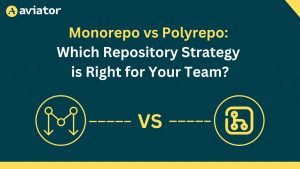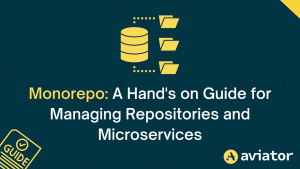How to Scale Release Management for Monorepos

Monorepos have become a powerful solution for managing extensive and intricate codebases in software development. By consolidating codebases into a single repository, teams can enhance code sharing and collaboration. However, this integration introduces its own set of challenges, especially in release management.
Consider a microservices application with numerous services, each having its own versioning and development team. In a traditional multirepo setup, each service operates independently with its repository and CI/CD pipeline. But when all these services are unified in a monorepo, managing releases, tracking changes, and maintaining version control across the application becomes more complex.
This article explores the intricacies of scaling release management in a monorepo environment. We will address the challenges development teams face, debunk common myths, and offer practical strategies to streamline your release processes. Whether you’re already using a monorepo or contemplating the switch, this guide will help you navigate the nuances of release management in this context.
Release Management Challenges in Monorepos
Monorepos present unique challenges for release management in complex deployments. Coordinating releases across interconnected services becomes critical. Changes to shared code can impact multiple components, making it essential to orchestrate releases to ensure compatibility and avoid disruptions.
Managing service discovery and routing is more complicated in a monorepo with multiple services. Effective communication between components, maintaining data consistency, and coordinating database migrations require meticulous planning. Versioning and changelog management for numerous services can be overwhelming, necessitating adapted strategies to handle interrelated services. Additionally, the volume of notifications for code reviews, pull requests, and builds can lead to information overload, requiring effective filtering and prioritization.
To tackle these issues, focus on filtering notifications to prevent missing important updates. As the monorepo grows, CI/CD processes might become bottlenecks, leading to long pipeline times and resource constraints. Clear code ownership and permissions management are vital in a monorepo with multiple teams, balancing independent work with collaboration. Finally, developing effective rollback strategies for complex, interdependent services and balancing individual service updates with overall system stability are crucial for successful release management.
Maintaining Code Ownership and Permissions
Managing code ownership and permissions in a monorepo involves balancing collaboration with clear boundaries. Here’s how to manage this effectively:
- Implement Access Controls and Branch Policies: Use your version control system’s features to set granular permissions. For example, use GitHub’s CODEOWNERS file or GitLab’s CODEOWNERS feature to assign reviewers to specific code sections. Implement branch protection rules to prevent direct pushes to critical branches and enforce code review processes.
- Establish Clear Code Ownership Guidelines: Document which teams or individuals are responsible for specific services, libraries, or modules. Keep this documentation accessible and updated. Use a CODEOWNERS file to enforce these rules through your version control system.
- Automate Code Reviews and Approval Processes: Utilize tools like Aviator or built-in features in GitHub or GitLab to streamline code reviews. Set up automated checks to run linters, style checkers, and tests before merges. Implement bots to assign reviewers based on the CODEOWNERS file and team workload.
- Implement a “Two-Approvals” Rule: For critical parts of the codebase, require at least two team members to review changes before merging.
By implementing these strategies, you can maintain clear code ownership, ensure proper access controls, and streamline review processes, enhancing code quality and easing release management.
Taming the Notification Noise
As your monorepo expands, managing the influx of notifications from code reviews, pull requests, and builds is crucial. Here are three strategies to handle notification overload:
- Configure Targeted Notifications: Set up notifications based on specific directories, file types, or tags relevant to different services or teams. This ensures developers receive alerts only for their areas of responsibility. In GitHub, use CODEOWNERS files; in GitLab, use approval rules.
- Leverage Chat Integrations and Bots: Integrate your monorepo with communication tools like Slack or Microsoft Teams. Use chatbots to aggregate and format notifications, reducing email clutter. Create dedicated channels for major services or teams where bots summarize relevant updates.
- Filter and Prioritize Notifications: Implement smart filtering systems to prioritize notifications based on relevance. Use machine learning to analyze interaction patterns and tailor notifications. Tools like Zapier or IFTTT can help create custom notification workflows.
These strategies will help reduce notification overload, allowing developers to focus on critical tasks and manage releases efficiently.
Continuous Integration and Deployment (CI/CD) to the Rescue
In monorepo architectures, traditional release management methods quickly become inadequate. Robust CI/CD pipelines are essential for transforming the release process into a streamlined, automated workflow.
For effective CI/CD in a monorepo, consider advanced strategies such as:
- Selective Builds: Implement intelligent build systems that only compile and test affected services, using tools like Bazel or Buck to analyze dependency graphs.
- Parallelized Workflows: Utilize CI/CD platforms that support extensive parallelization. For example, Buildkite allows distributed builds across numerous machines, significantly reducing build times.
- Caching Strategies: Use sophisticated caching for build artifacts, test results, and dependencies to avoid redundant work.
- Dynamic Pipeline Generation: Employ CI/CD tools that support dynamic pipeline creation. Buildkite’s dynamic pipelines, for example, generate build steps based on the current commit, ensuring relevant services are built and tested.
Integrate monorepos with CI/CD platforms using optimized webhooks and SCM-aware build configurations. Implement release strategies like feature flags, canary releases, and blue-green deployments to maintain flexibility and minimize risks.
Automate versioning and changelog generation using tools like Commitlint, release-please, or Conventional Changelog, and integrate semantic-release for automatic version bumps. Utilize tools like Lerna or Nx for managing versions across services, and automate Git tags and releases as part of your CI/CD pipeline.
Coordinate multi-service releases with dependency graphs, staged releases, and contract testing to ensure API compatibility and manage dependencies effectively.
Rollback and Recovery Strategies
Robust rollback and recovery strategies are essential in a monorepo environment with interconnected services. Effective strategies include:
- Implement Circuit Breakers, Retries, and Fallbacks: Use these patterns as shared libraries to maintain consistent error handling across services.
- Enable Blue-Green and Canary Deployments: Blue-green deployments allow instant rollback by switching traffic between environments, while canary releases enable gradual rollouts to detect issues early.
- Develop a Comprehensive Disaster Recovery Plan: Include strategies for maintaining system snapshots and data backups. Regularly test and update the recovery plan to handle the entire system state.
By adopting these strategies, you can ensure stability and reliability during releases in a monorepo environment, mitigating risks and maintaining service quality.
Conclusion
Scaling release management in a monorepo presents unique challenges, but with the right strategies and tools, it can enhance software delivery efficiency and reliability. We’ve explored various aspects of managing releases, including maintaining code ownership, handling notification noise, and leveraging advanced CI/CD techniques. Embrace automation and tools designed for monorepo architectures to overcome performance bottlenecks and streamline release processes. Clear code ownership, effective notification management, and well-defined rollback procedures are vital for successful release management. By mastering these techniques, teams can manage complex deployments with greater agility, reliability, and confidence, ultimately accelerating value delivery to end-users.









